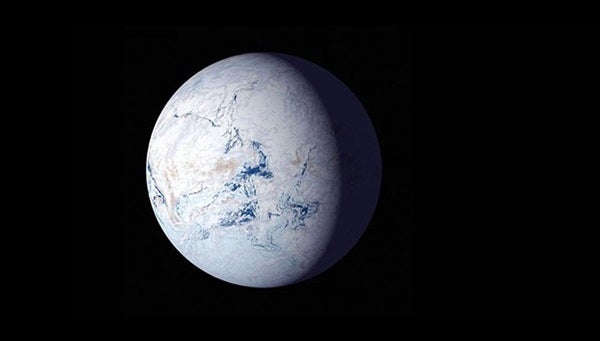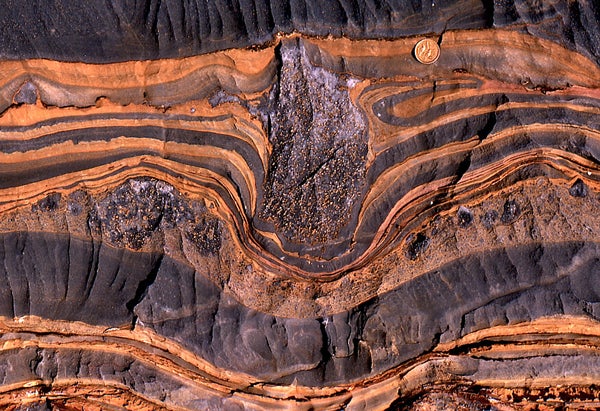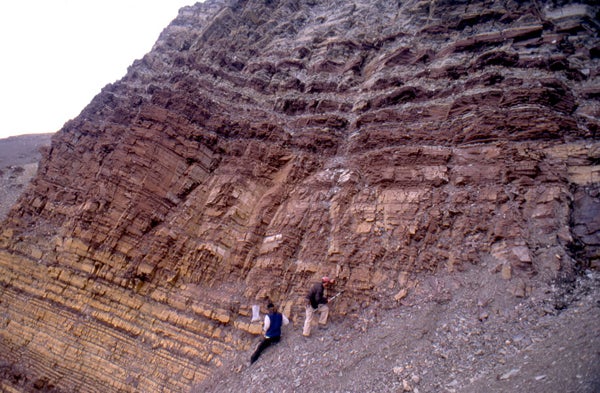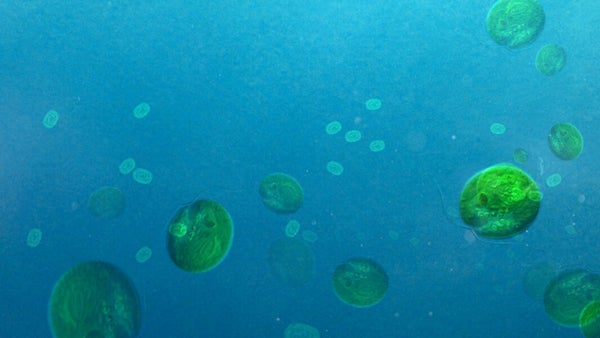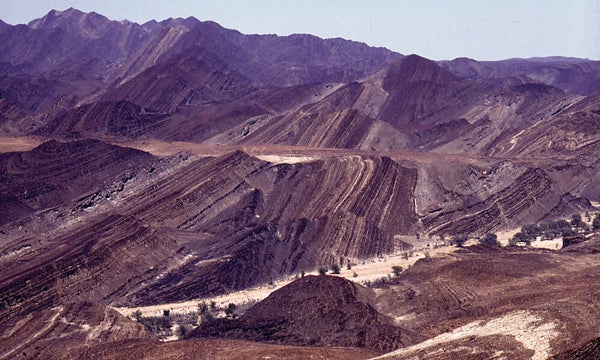Drawing on evidence across multiple continents, scientists say these Snowball Earth events may have paved the way for the Cambrian explosion of life that followed — the period when complex, multicellular organisms began to diversify and spread across the planet.
When Caltech geologist Joe Kirschvink coined the term Snowball Earth in 1989 — merging ideas that some geologists, climate physicists and planetary chemists had been thinking about for decades — many earth scientists were skeptical that these cataclysmic events could really have occurred. But with mounting evidence in support of the theory and new data that help pin down the timing of events, more scientists have warmed up to the idea.
Paul Hoffman, a geologist at the University of Victoria in British Columbia, has helped pioneer Snowball Earth research over the past 25 years. Among other things, he amassed 50 months’ worth of fieldwork in Namibia, where he gathered evidence of ancient glacial activity in rocks that are interspersed with limestone. Since limestone tends to form in the warmest parts of the ocean, this sandwich-like pattern supports the idea that glaciers covered all of the Earth, cold as well as warm spots, during Snowball Earth episodes. Knowable spoke with Hoffman, who recounts his life work in the Annual Review of Earth and Planetary Sciences, about the evolution of the Snowball Earth theory and what questions remain. This conversation has been edited for length and clarity.
The name describes its appearance from outer space — a glistening white ball. The ice surface is mostly coated with frost and tiny ice crystals that settled out of the cold dry air, which is far below freezing everywhere. Gale-force winds howl in low latitudes. Beneath the floating ice shelf, a dark and briny ocean is continually stirred by tides and turbulent eddies generated by geothermal heat slowly entering from the ocean floor.
What first tipped off geologists that this could have happened?
Geologists were struggling to understand what they saw in the geologic record — that not too long before the first appearance of complex life, there was unmistakable evidence of glaciation even in the warmest areas of the Earth. Geologists had a very difficult time understanding how this was possible.
The deposits that glaciers leave behind are very distinctive. They look like cement that has been dumped out of a cement truck. These Snowball ice sheets would have flowed from the continents out onto the ocean, so we have a lot of deposits that formed in the marine environment where you get what are known as dropstones: pebbles or boulders that are out of place. Very often, you see structures related to the impact, as if the stone was somehow dropped and then plunked into the underlying sediment. It’s difficult to imagine what, other than floating ice, could have possibly transported this debris; trees, which can carry soil and stones out to sea in their roots, had not yet evolved.
I had known about the hypothesis since even before I was interested in working on the problem myself. Joe Kirschvink at Caltech told me about it a few months after he had the idea in 1989, but he never did anything more with it at that time. I liked it because I like ideas, but there was a credibility gap, so before our work, the hypothesis was dormant.
The biggest problem was that because the conditions were so different from any other time in Earth’s history, we didn’t understand the implications of the hypothesis well enough to know whether any given bit of geologic evidence was either for or against it. We had to have climate models to see what actually happens under Snowball conditions, and that modeling, developed later, has been extremely important.
My main contribution was making the case that it was a credible scientific hypothesis by arguing, from different disciplines within geoscience, that there was a lot of geological evidence consistent with the predictions. As I often like to say, new ideas or hypotheses are like small children: It’s best not to judge them too early because you don’t know what they are going to be like as adults. Very often, the problem with new ideas is not that they are wrong, but that they are incomplete.
What triggered these events?
That’s the “why” question and that’s maybe the most difficult one. I don’t think there is a consensus on this. There are a number of factors that contributed, and I think it is useful to look at this in two ways. First of all, what was the general condition that made for a colder climate and therefore made the Earth more susceptible to this runaway ice growth phenomenon? And then what was the immediate trigger that tipped it over the edge?
As for what actually caused the immediate trigger, attention has focused in recent years on a sequence of very large volcanic eruptions that occurred in what is now the high arctic of Canada. These eruptions occurred around 717 million and 719 million years ago. When you get fire fountains — lava that comes out of one place over a period of weeks or months — you get a strong thermal upwelling in the atmosphere from the heating effect of that lava. These upwellings can loft sulfur aerosols into the stratosphere where they hang around for a significant amount of time. These sulfur gas particles reflect incoming solar radiation and have a strong cooling effect. Because of the coincidence in timing between these eruptions and the onset of the first and longer of the two Snowball Earths, it’s been postulated that that may have been the immediate trigger.
What did life on Earth look like at the time, and how did it change as a consequence of these events?
There were certainly bacteria and there were also algae and unicellular primitive animals, or protists.
There is also evidence that the first multicellular animals originated at this time, probably something like sponges. Why is a matter of speculation: There are a number of ideas on this, but they are difficult to test. One idea is that on Snowball Earth, ecosystems may have been more isolated from one another and this might be a situation that would be helpful for evolving new forms of life, and particularly forms of life that are altruistic — ones with cells that find that there is an advantage in working together rather than working individually. So more isolation of different ecosystems might have allowed certain ecosystems that had a higher proportion of these multicellular altruists to establish a foothold.
I think I underestimated how emotional people would get about it and how wedded people were to the idea that the Earth has never really been greatly different than it is today. In the 19th century, people had a difficult time believing that most of northern Europe and North America were covered by an ice sheet only 20,000 years ago. That was as hard for a 19th-century geologist to accept as Snowball Earth has been for 20th-century geologists.
For a long time we had a lot of evidence for glaciation at low latitude and in the warmest parts of the Earth, but we didn’t really have a good idea of the dates of these events. It was sort of embarrassing. But between 2010 and 2014 that situation dramatically changed. We now have pretty precise estimates from two very different dating techniques, and it’s impressive that they are giving highly consistent results. I think working out the timescale has caused a majority of geologists working on the problem to now accept the Snowball hypothesis.
Alternative theories have arisen over the years, including what is called the Slushball theory — a less extreme version of Snowball Earth. How does pinning down the dates help sort out these alternative theories?
In the Slushball scenario, carbon dioxide would start building up very quickly, so the glaciation would be short-lived and the ice would retreat gradually. This is not what we see in the geologic record. We now know that the first Snowball lasted for 58 million years and that is completely inconsistent with the Slushball idea. Also, we see the Snowball glaciations terminate extremely abruptly and they are followed by clear evidence of a complete and abrupt climate reversal, a very hot period. That is not explained by the Slushball model.
I don’t think there are any other alternatives that satisfy the evidence.
The dating has created a new set of problems. One thing the dating revealed was that the two Snowball Earths occurred in rapid succession and were very unequal in duration. The first one lasted 58 million years and the second one only lasted 5 million to 15 million years. So we don’t know why there is this great disparity in how long the glaciations lasted. And why was it that there was just this short interval between the two? There’s only about 10 million years when there was no ice at all and then suddenly the planet went back into Snowball Earth. So why two in rapid succession? And why wasn’t there a third one or a fourth one? These are new questions that have arisen as a result of our understanding of the timing.
Could it happen again in the future?
I don’t think we are in a very good position to say whether or not it’s likely to happen in the future. The future is a long time. I think we can say it is not going to happen in the next several tens of thousands of years.
Why study Earth history?
The history of our planet is one of the greatest stories. Because we live here and we are dependent on this place, I think it is very important to understand that the Earth has not always been the way it is today. Snowball Earth is an example of the kinds of amazing things that the Earth has been through that we would never have suspected if we didn’t investigate the geologic record.
Dealing with Snowball Earth has been fantastic — it’s been the most intense learning experience of my life, and I never anticipated that it would be accepted in my lifetime.
And you’re still at it, after 25 years?
I’m still doing fieldwork in Namibia, as a 77-year-old. It’s just a large and fascinating problem. It’s hard to pull myself away.
This article originally appeared in Knowable Magazine, an independent journalistic endeavor from Annual Reviews. Sign up for the newsletter.

